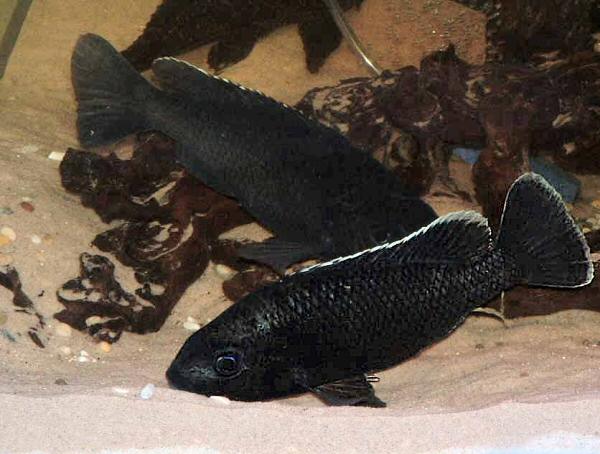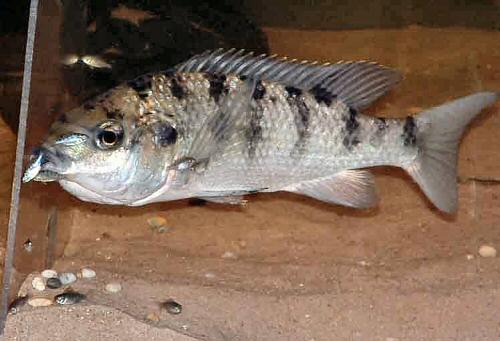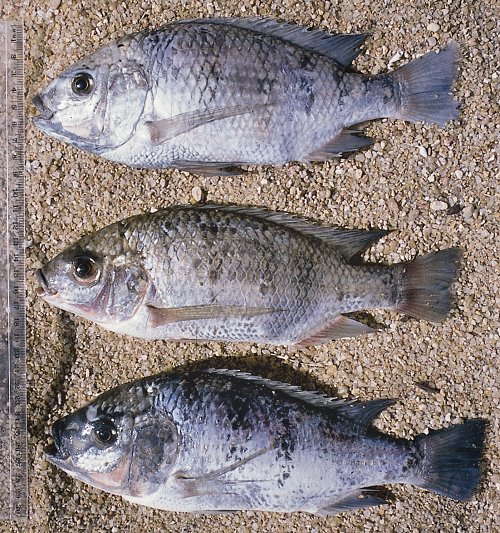
A territorial male of Oreochromis (Nyasalapia) karongae from West Thumbi Island (photo © by George F. Turner)

A territorial male of Oreochromis (Nyasalapia) karongae from West Thumbi
Island (photo © by George F. Turner)
Oreochromis (Nyasalapia) karongae (Trewavas)
Text and photos by Guest Author: Prof. George F. Turner (Bangor University, UK)
This is one of the three 'Chambo' species endemic to Lake Malawi. The chambo are the most valuable food fishes in Malawi, but populations collapsed in the 1990s as a result of overfishing. The three species are believed to be more closely related to each other than to any other tilapia species (Sodsuk et al., 1995), and have probably evolved within the lake. Like other species of the subgenus Nyasalapia, males of O. (N.) karongae develop long branched genital 'tassels' that serve as egg dummies (as illustrated for O. (N.) squamipinnis). Territorial male O. karongae are jet black, with a white dorsal fin margin (see photo above). In northern Malawi, the African name for these black breeding males is "Manindi." Other common names applied to this species include Saka, Biriwiri, Chidyakolo, and Chambo (a general term for tilapias).
The species was described from specimens collected from Karonga in the far north of Lake Malawi. These typically have stout pharyngeal bones with a large toothed area. Specimens from Lake Malombe and the southern part of the south-eastern arm of Lake Malawi have very slender pharyngeal bones and jaws with few rows of teeth (usually 4). These used to be considered a separate species, Tilapia saka Lowe, 1953 [more recently Oreochromis (Nyasalapia) saka (Lowe)], but Turner & Robinson (1991) considered this to be a junior synonym. Some specimens from Cape Maclear and Makanjila areas have stout pharyngeal bones like the Karonga fish. In these areas, the fish sometimes have broad bands of jaw teeth: up to 15 tooth rows on occasion (as in the photo at right). This may be an adaptation to combing food from filamentous algae growing on rock surfaces, like the mbuna Petrotilapia. Immature fish and females are hard to tell apart from those of O. squamipinnis. In the photo below taken at Cape Maclear, of immatures about 25cm (10 inches) total length, the middle fish is O. karongae, the upper one O. squamipinnis and the lower one O. lidole. As is characteristic of the species, the O. karongae is more slender with a small head and jaws and has a more brownish hue. The dorsal fin lappets are often yellow, which is distinctive in the southern part of the lake. In other parts of the lake they can be harder to tell apart. (Continued after photos)

Jaws of an Oreochromis karongae from southern Lake Malawi,
to show the numerous rows of teeth (photo © by G.F. Turner)

A courting pair of Oreochromis karongae in an aquarium (photo © by G.F. Turner)

A female Oreochromis karongae guarding fry in an aquarium (photo © by G.F. Turner)

Comparison of (top to bottom) Oreochromis squamipinnis, O. karongae, and O. lidole
captured at Cape Maclear (photo © by George F. Turner)
The bright yellow fish illustrated below is a rare xanthochromatic form. It is not an albino, because it has black eyes. Despite examining many thousands of chambo in the course of 3 years of field research, this was the only live yellow chambo I encountered. There was another one preserved in the museum at the Monkey Bay Fisheries lab. They are obviously not common, and probably are rare mutants, rather than a morph that is maintained by some kind of selection (as is likely the case with Orange and OB-blotched morph mbuna). However, both specimens had survived to maturity, so being bright yellow need not always be a handicap. (Continued below)

A rare xanthochromatic individual of Oreochromis karongae (photo © by G.F. Turner)
The species is found in Lake Malawi, the Upper and Middle Shire River and Lake Malombe. A population described as O. chungruruensis was described by Ahl (1924) from two small crater lakes located a few kilometers to the north of Lake Malawi, L. Kingiri and L. Chungruru. These lakes may have been populated with this species at a past period of higher lake levels, but they may have been introduced by humans. Dwarf O. lidole are found in the same lakes, and I have found dwarf O. squamipinnis and O. karongae in Lake Chiwondo south of Karonga. It is quite likely that O. chungruruensis is just a dwarf form of O. karongae, in which case Oreochromis chungruruensis would be the senior synonym and should be used for all populations of the species.
Oreochromis karongae reaches a maximum size of around 38cm (15 inches) total length. O. karongae can be seen in loose shoals in many areas of the lake, as in the photo at left by Eva Hert, taken at Thumbi West Island. They feed by rasping the surfaces of rocks and weeds, by sifting sediment and by feeding in the water column. They eat mainly algae, detritus and zooplankton (Turner et al., 1991).

A small shoal of Oreochromis karongae at Thumbi West Island
(photo © by Eva Hert)The breeding season runs from July to March, peaking around September and again in February. In Lake Malombe there is just a single peak around July to October. Like other Oreochromis, they are maternal mouthbrooders. Males dig large spawning platforms from the shallows down to depths of at least 28 meters (90 feet). Like other chambo, they construct a slightly raised bowl-shaped central spawning cone inside the larger pit.
Oreochromis karongae is easily kept and bred in the aquarium. It matures precociously at about 12cm (5 inches) TL, although it keeps on growing. It is a relatively peaceful species, and males don't seem to bother to try to control territories until females are nearly ready to spawn. Non-territorial males are pale grey and are not usually attacked by the dominant male. If provided with sand, the males will build the characteristic double pit nests in captivity. However, they can breed in a bare tank. When the young are ready to be released, females develop a dark bar across the forehead, and dark eyes. The fry grow rapidly on a diet of flake or pellet food and are quite good at keeping the aquarium glass clean.

|
Suggested citation of this page: Turner, G.F. (2003) Oreochromis (Nyasalapia) karongae (Trewavas). http://malawicichlids.com/mw10001a.htm. In: "The Cichlid Fishes of Lake Malawi, Africa" (M.K. Oliver, webmaster), http://malawicichlids.com. Accessed [date]. | |
| Page last revised: 29 Augusst 2016 Revised page by G.F. Turner first posted: 27 February 2003 Web Author: M. K. Oliver, Ph.D. Copyright © 1997-2021 by M. K. Oliver, Ph.D. - ALL RIGHTS RESERVED |